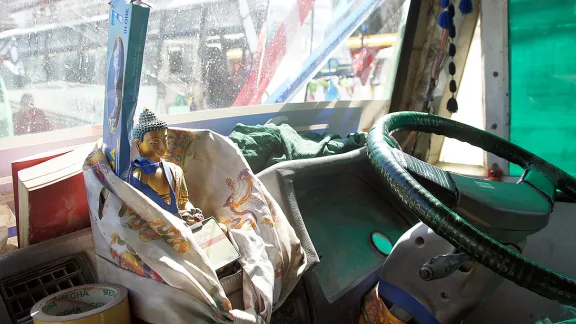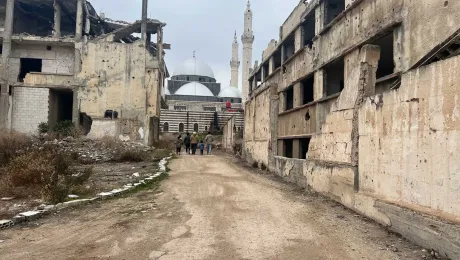
Buddha on the dashboard in a Nepali bus. Photo: LWF/ C. Kästner
There is no road. Sitting on the right side of the bus, you stare into an abyss, and the bus is leaning dangerously towards it. This road is fairly new, something which cannot be said for the bus. Together with pot holes, rocks and a mountain path slightly broader than the bus, it’s a scary combination. The bus moves as a boat, leaning left and right, and shaking our sore muscles from head to toe. No seat belts. We bump into another bus.
Prayers and humor make it into one sentence: Please Lord let us get home and tell LWF to do more infrastructural work in Nepal.
The bus is a work of art. Mirrors on the ceiling, colorful garlands on the windshield, red, blue and yellow scarfs wave from the rear-view mirrors. Nepali Bollywood-style music blares so loud it’s almost painful. On the front of the bus is a painting of the Hindu God Shiva, part of the triune deity Brahma-Vishnu-Shiva. He is also known as the destroyer. Not very comforting in this situation.
The driver’s skills are amazing. In true backstage fashion, we get almost all the bus riding experience a true local would have in Nepal.
Rivers are just for driving through. As are potholes and landslides. Inside the bus, people cover their faces so we would not inhale too much dust. There are people sitting and standing everywhere.
On the first day, we hear an explosive noise. Seems like a tire blew. The bus carries on though, there are four wheels in the back.
On the second day, the bus breaks down. Something about air, pressure and brakes. It takes about forty minutes to get a new bus from the nearest town. Time we spend looking for shaligrams (ammonite fossils which are worshipped as manifestations of the Hindu God Vishnu by Hindus) on the Kali Gandaki riverside. Then we get a new bus, green with Buddha on the front, and continue our ride.
It seems to be part of the Nepali understanding of customer service to refill diesel and fix broken doors about ten minutes before the final destination. As true Backstage Pass participants, we of course happily devote another half-hour for this insight into a local mechanic’s work.
On the other hand, the bus drivers go slowly, as carefully as possible, and they brake for anything which might cross the road. That does not include tourists on motorcycles, but certainly cows, mules, baby goats and even chicken. After all, Shiva is also the protector of the animals.
Related Blog Posts



